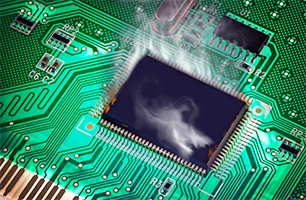Do Fanless Computers Overheat?
It is intriguing, to say the least, that many of today’s industrial computers can run without fans. I am often times asked what keeps them from overheating. Just a few years ago, computers required a CPU cooler fan and multiple case fans to operate without overheating. Now many computer enclosures don’t even have ventilation holes. “How can this be”, they say, “am I dreaming again?”, and then they are shocked when I pinch them and they don’t wake up. Fanless computers are made possible because of some recent advancements in CPU architectures and clever thermal design.
 With the advent of laptops, there was a drive to reduce the power consumption of CPUs to save battery life. Mobile CPUs were designed to take the place of desktop CPUs in laptops for this reason. ULV (Ultra Low Voltage) mobile CPUs with even lower power consumption were developed to prolong battery life further and be integrated into the thinnest notebooks. Fanless touchscreen panel PCs and fanless box PCs take advantage of the low power dissipation of these new processors. These industrial computers dissipate power generated by the CPU directly through the metal chassis, which acts as a large heat sink. The surface of the CPU is physically mated to the metal chassis with a heat pipe, and the large surface area and shape of the chassis allows the heat to be dissipated into the ambient air surrounding the computer, so the CPU remains within its rated operating temperature. The benefit of a fanless computer is that they have no moving components to fail, they are protected from dust, and they can even be completely sealed and protected from liquids.
With the advent of laptops, there was a drive to reduce the power consumption of CPUs to save battery life. Mobile CPUs were designed to take the place of desktop CPUs in laptops for this reason. ULV (Ultra Low Voltage) mobile CPUs with even lower power consumption were developed to prolong battery life further and be integrated into the thinnest notebooks. Fanless touchscreen panel PCs and fanless box PCs take advantage of the low power dissipation of these new processors. These industrial computers dissipate power generated by the CPU directly through the metal chassis, which acts as a large heat sink. The surface of the CPU is physically mated to the metal chassis with a heat pipe, and the large surface area and shape of the chassis allows the heat to be dissipated into the ambient air surrounding the computer, so the CPU remains within its rated operating temperature. The benefit of a fanless computer is that they have no moving components to fail, they are protected from dust, and they can even be completely sealed and protected from liquids.
When selecting a fanless box PC or fanless touchscreen computer, it is important to consider the environment where it will be used. Every fanless industrial computer has an operating temperature rating, and this rating specifies that the computer will operate normally when the ambient air surrounding the chassis is within this operating temperature range. For example, many fanless box PCs and touchscreen PCs have an operating temperature range of 0~50 Celsius (34~122 Fahrenheit), and others may have a wider operating temperature range of -20~60C (-4~140 Fahrenheit). Most indoor applications such as factory floors or electrical control cabinets have ambient air temperatures well within this rating.
Other industrial computer applications such as vehicle PCs, agriculture equipment, and public kiosks, may be outdoors or in areas that are not temperature controlled. These types of applications typically require an industrial computer with a wide operating temperature range. Another environmental consideration when using fanless industrial computers is ventilation. In some situations, it is necessary to install a computer in a confined area or even a sealed box, such as a Hoffman enclosure. When this is done, the ambient air temperature inside the enclosure should be referenced for computer operating temperature, and one must take into account the heat generated by the computer itself.
The heat generated by the fanless computer will raise the ambient temperature inside the enclosure. The size of the enclosure and material composition have an effect on the ambient temperature. A smaller enclosure would have less volume and less surface area to dissipate heat to the outside world than a larger enclosure. Sealed enclosures may require a fanless box pc with a wide operating temperature.
If a fanless computer is operating in an environment outside of its rated operating temperature range, the computer performance may be reduced, and the computer life may be shortened. Intel CPUs have built in protection called thermal throttling to protect themselves from being damaged by excessive heat. If an Intel CPU senses that it is getting too hot, it slows down the processor clock speed to reduce the heat it is generating. This reduced clock speed reduces the CPU performance, and this can impact the performance of the application. If fanless computers are continuously operating in environments outside of its temperature range, the life of internal components such as memory, storage, and LCD may be shortened.
Fanless panel PCs and fanless box PCs are the best solution for applications in harsh environments where they may be exposed to dust or mechanical shock and vibration. They are frequently used in manufacturing areas and shop floors where airborne particulates, sawdust, organic materials, and metallic dust are prevalent. Fanless industrial computers are used in trains, vehicles, and agriculture equipment where they are protected from mechanical shock and vibration. Fanless industrial computers offer the performance, reliability, and longevity improving the value of any industrial computer application.
Previous Article
Optical Bonding Displays - Does Your Industrial Computer Need Them?












